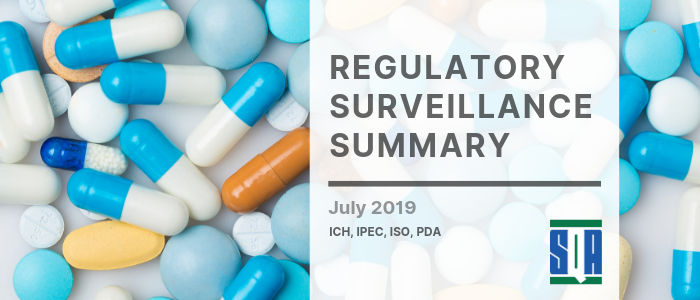Regulatory Surveillance Summary July 2019
SQA Regulatory Surveillance Summary for Q2, 2019
International Council for Harmonization (ICH) Guidance
ICH Harmonized Guideline, Optimization of Safety Data Collection, E19, Draft April 2019
This Guideline is intended to provide internationally harmonized guidance on an optimized approach to safety data collection in some late-stage pre-approval or post-approval studies when the safety profile of a drug is sufficiently characterized. Optimization of safety data collection using a selective approach may improve the efficiency of clinical studies while reducing the burden to study participants. Adoption of an internationally harmonized approach to selective safety data collection may facilitate global participation in clinical studies.
M10 Bioanalytical Method Validation, Draft Guideline, February 2019
This new multidisciplinary guideline will apply to the validation of bioanalytical methods and study sample analyses in non-clinical and clinical studies. Reliable data derived through validated bioanalytical methods are key for the review of marketing authorization applications. This guideline will provide recommendations on the scientific regulatory requirements for bioanalysis conducted during the development of drugs of both chemical and biological origins. It will also address issues related to method validation by considering the characteristics of the analytical methods used in bioanalysis, such as chromatographic assay and ligand binding assay. A harmonized bioanalytical method validation guideline will promote prompt, rational, and effective non-clinical and clinical studies, thereby advancing the mission of the ICH.
Q3D(R1) Guideline for Elemental Impurities, Final Version, March 2019
ICH Q3D Elemental Impurities is a quality guideline for the control of elemental impurities in new drug products (medicinal products), and it establishes Permitted Daily Exposures (PDEs) for 24 Elemental Impurities (EIs) for drug products administered by the oral, parenteral, and inhalation routes of administration. In addition, guidance is provided in Q3D on how to develop an acceptable level for EIs for drug products administered by other routes of administration. In March 2019, the Q3D(R1) Guideline, which was the result of a revision of the PDE level for Cadmium by inhalation in the Q3D Guideline, reached Step 4 of the ICH process.
International Pharmaceutical Excipients Council (IPEC)
IPEC Position Paper: Supply Chain Security of Pharmaceutical Excipients, January 2019
The IPEC Federation has published a new position paper on Supply Chain Security for Pharmaceutical Grade Excipients. Supply chain security requires the protection and control of pharmaceutical excipients across the entire supply chain, downstream from the excipient manufacturer to the finished dosage form producer. Product quality, traceability, and integrity must be ensured throughout the supply chain in order to minimize the risk to patients that may result from the use of falsified and sub-standard excipient products. This paper was written in response to many tragedies, even deaths, caused by the use of falsified excipients in recent decades. Today’s increasingly complex global supply chains create additional risk and therefore considerations related to excipient security.
Aimed at providing support to all parties involved in the supply chain, such as pharmaceutical excipient manufacturers, distributors (re-packers, bulk storage and packed storage warehouse providers), traders, brokers, carriers, and other service providers, the paper summarizes existing applicable regulations and various tools supporting good practices for supply chain security and ultimately drug safety. These include IPEC Federation’s Good Distribution Practices Guide for Pharmaceutical Excipients, IPEC-Americas Risk Assessment Guide, and the EXCiPACT and NSF/IPEC/ANSI 363 certifiable GMP and GDP standards for excipient suppliers.
The IPEC Federation specifically emphasizes that while overall responsibility remains with the finished dosage form manufacturer, each participant in the supply chain, both up and downstream, has responsibilities for its own specific area of activity. Establishing controls at each interface is imperative, where the level of control required can be determined using IPEC’s Risk Assessment Guides. These principles should establish and ensure supply chain security of excipients, thereby minimizing risk to patients.
International Organization for Standardization (ISO)
ISO 22000:2018, Food Safety Management Systems – Requirements for Any Organization in the Food Chain, 2nd Edition, June 2018
This document specifies requirements for a food safety management system (FSMS) to enable an organization that is directly or indirectly involved in the food chain to:
- Plan, implement, operate, maintain, and update a FSMS providing products and services that are safe, in accordance with their intended use;
- Demonstrate compliance with applicable statutory and regulatory food safety requirements;
- Evaluate and assess mutually agreed upon customer food safety requirements and to demonstrate conformity to them;
- Effectively communicate food safety issues to interested parties within the food chain;
- Ensure that the organization conforms to its stated food safety policy;
- Demonstrate conformity to relevant interested parties;
- Seek certification or registration of its FSMS by an external organization or make a self-assessment or self-declaration of conformity to this document.
All requirements of this document are generic and are intended to be applicable to all organizations in the food chain, regardless of size and complexity.
This second edition cancels and replaces the first edition (ISO 22000:2015), which has been technically revised through the adoption of a revised clause sequence. It also incorporates the Technical Corrigendum ISO 22000:2005/Cor.1:2006. Companies certified to the ISO 22000:2005 standard have to transition their certificate to ISO 22000:2018, and there is a three-year transition period until 29 June 2021 according to International Accreditation Forum (IAF) Resolution 2018-15.
https://www.iso.org/standard/65464.html
Parenteral Drug Association
PDA Technical Report No. 82 (TR 82) Low Endotoxin Recovery, March 2019
This Technical Report aims to describe the underlying mechanisms and contributing factors of Low Endotoxin Recovery (LER), summarize the potential clinical impact of the LER phenomenon, present guidelines for developing LER hold-time study design, and provide strategies for the mitigation of LER. This Technical Report can be purchased through the PDA Store (https://www.pda.org/bookstore/product-detail/4894-tr-82-low-endotoxin-recovery) or is available to members via the Technical Report portal (cut and paste the link below into your browser): https://techpubportal.pda.org/publication/?view=issuelistBrowser&l=1&m=53810#{“issue_id”:572956,”view”:”issuelistBrowser”}


Comments are closed.